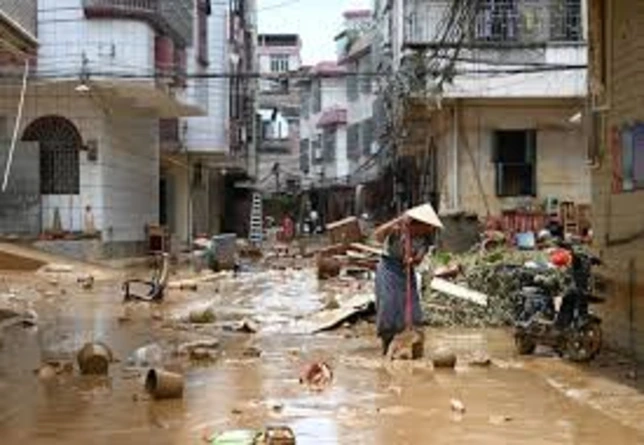In recent weeks, China flooding has dominated headlines as torrential rains continue to batter provinces across the country. Rivers have breached their banks, dams are under immense pressure, and millions of people have been forced to evacuate. The scale of devastation is alarming—not only for those living in affected areas but for the global community watching the climate crisis unfold.
This blog explores the 9 most devastating impacts of China flooding, why it matters globally, and what it signals for the future.

Table of Contents
What’s Causing the Severe China Flooding in 2025?
The current wave of China flooding can largely be attributed to extreme rainfall triggered by prolonged monsoon conditions, intensified by climate change. Southern and central China have experienced rainfall exceeding 400mm in just a matter of days—levels not seen in decades.
Cities like Guangzhou, Wuhan, and Chongqing have seen entire districts submerged. Infrastructure, agriculture, and lives have been disrupted as the nation grapples with water levels that continue to rise.
1. Over 1 Million People Displaced
So far, over 1.2 million people have been forced to evacuate from their homes due to rising floodwaters. Temporary shelters in schools, sports complexes, and government buildings are overwhelmed. Aid organizations are reporting shortages of clean water, food, and medical supplies.
2. Agricultural Land Wiped Out
Vast acres of rice, wheat, and vegetable farms have been flooded, particularly in Hunan and Jiangxi provinces. China is the world’s largest producer and consumer of rice, and this disruption could impact global food supply chains. Damage to crops may also trigger short-term inflation on staples.
3. Infrastructure Collapse
Bridges, roads, and tunnels have collapsed under the weight of water or been washed away. One notable incident involved a bridge in Guangxi province being completely severed from both ends. Emergency crews have been working nonstop to stabilize embankments and reroute traffic.
4. Threat to Major Dams and Hydropower Plants
China’s massive Three Gorges Dam, the largest hydroelectric power station in the world, is under critical monitoring. While officials claim it remains structurally safe, hydrologists warn of increasing pressure as upstream reservoirs overflow. Smaller dams in the region have already cracked or failed.
5. Waterborne Disease Risks Surge
With drinking water sources contaminated and poor sanitation in flooded zones, health experts warn of a surge in diseases such as cholera, hepatitis A, and leptospirosis. The Ministry of Health is deploying medical teams and mobile clinics to high-risk areas.
6. Economic Costs Skyrocket
Preliminary estimates suggest the flooding could cost over $18 billion in damages. This includes losses in agriculture, transportation, manufacturing, and tourism. As cleanup begins, local governments are scrambling for emergency funding and disaster relief.
7. Urban Poor Hit Hardest
In cities, it’s the informal settlements—often on low-lying land—that have suffered the most. These communities, lacking proper drainage systems or flood defenses, face a disproportionate burden of displacement, disease, and loss of livelihood.
8. Global Supply Chains Affected
Many of the affected provinces are home to major manufacturing hubs that supply goods ranging from electronics to automotive parts. Factory shutdowns and shipment delays are expected to ripple across global markets in the coming weeks.
9. Climate Change Under Scrutiny
The repeated cycles of extreme flooding in China have prompted renewed scrutiny of global climate policies. With weather patterns growing more erratic, environmental groups are urging stronger climate adaptation measures—not just in China, but worldwide.
Why the China Flooding Should Concern the World
This isn’t just a domestic crisis. When China flooding disrupts its agricultural output or manufacturing pipeline, the rest of the world feels it too. Experts say the floods could also influence global commodity prices, stock market volatility, and even diplomatic relations if aid or resource negotiations are required.
The event also adds fuel to the global debate over climate policy. If even one of the world’s most technologically advanced nations struggles with managing natural disasters, what hope do smaller nations have?
Government and Community Response
The Chinese government has deployed over 250,000 emergency personnel, including military and firefighting units. Temporary barriers and sandbags are being used to protect critical infrastructure. Drone technology is being used to survey affected areas and identify at-risk structures.
Meanwhile, citizens are organizing through social media to provide rescue, deliver supplies, and reunite families. International aid offers have come in from neighboring countries, although some criticism has surfaced about the lack of transparency regarding flood preparedness.
How the China Flooding Compares to Past Disasters
The 2025 China flooding is drawing comparisons to the 1998 Yangtze River floods, which claimed over 4,000 lives and displaced 15 million. While death tolls are lower this time due to better early-warning systems and rapid response, the scale of infrastructure damage is greater—a sign that climate-driven disasters are evolving.
Lessons for the U.S. and the World
China’s ongoing disaster serves as a stark reminder for U.S. cities vulnerable to floods, such as Miami, New Orleans, and New York. The event underscores the need for:
- Modernized flood control systems
- Urban planning reforms
- Early warning technologies
- Community education and resilience
Final Thoughts
The 2025 China flooding is more than a natural disaster—it’s a global event that raises urgent questions about climate resilience, international cooperation, and disaster readiness. The world is watching, not just with sympathy, but with a growing sense of urgency about what this means for the future.
Disasters like this remind us that climate change is not a future threat—it’s here, and it’s flooding our cities, displacing our communities, and testing our systems.
Frequently Asked Questions (FAQ)
Q1: What provinces are most affected by the China flooding?
A: Guangdong, Hunan, Jiangxi, and Sichuan have experienced the worst damage due to heavy rainfall and overflowing rivers.
Q2: Is the Three Gorges Dam at risk?
A: It’s being closely monitored. Officials say it’s safe, but hydrologists remain concerned about upstream water pressure.
Q3: How does China’s flooding affect the U.S.?
A: The floods can disrupt supply chains, increase product prices, and influence global commodity markets. They also impact climate diplomacy.
Q4: Has China asked for international aid?
A: Not formally, though offers have come in from regional allies. The government has focused on domestic response efforts.
Q5: What are the long-term implications of repeated flooding in China?
A: Beyond immediate recovery, China faces mounting challenges in urban planning, infrastructure resilience, and global leadership on climate adaptation.
- 7 Alarming Revelations from the Latest COVID Vaccines Heart Risk Warning Update
- 9 Shocking Truths About Anna Wintour That Changed Fashion Forever
- 7 Exciting Facts About What Time Does Squid Game 3 Come Out (And What It Means for Fans!)
- 5 Fascinating Truths Behind the Enigma That Still Baffle the World Today
- 7 Powerful Reasons Why ‘Matlock’ Still Captivates Audiences in 2025

2 thoughts on “9 Devastating Impacts of the Latest China Flooding Crisis You Need to Know”